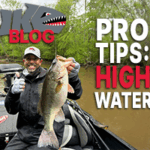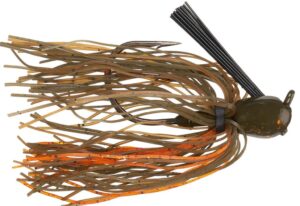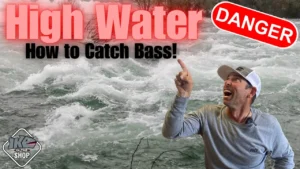
You guys hit us up all the time with questions, and this one kept coming up: How do you fish high water? I’m talking about after heavy rain, when water starts rising, gets dirty, and spreads out all over the place. It can be confusing, frustrating, and flat-out tough. But don’t worry, I’m going to walk you through it.
Understanding High Water
Let’s start with a little theory. I’ve said this before and I’ll say it again because it’s THAT important:
Rising Water = Rising Fish
Falling Water = Falling Fish
That’s the rule. Simple. When water starts coming up, whether it’s from rain, storms, or flooding, the fish move up too. They follow the water into newly flooded areas because that’s where the food is. Bluegill, shad, crawfish; they all follow the water. Bass are predators, and they go right with them.
But here’s the problem: when everything’s flooded, fish can be anywhere. That field that used to be dry? Now it’s under two feet of water and full of bass. That’s a lot of water to cover.
Where to Look First: Hard Edges
The first thing I look for in high water is what I call a hard edge. That’s a place where the water can’t keep spreading. Think about a seawall, a steep bank, a bluff, or even a hill in the middle of a flat. That hard edge becomes a boundary that keeps fish from going deeper into the woods or brush. It focuses the fish.
If you look at a flat and all you see is flooded trees for miles? Skip it. But if you find a flooded flat with a seawall or steep incline…boom, that’s a fish magnet!
Find Cleaner Water
Here’s another big key: look for clearer water. Rising water usually brings in mud and dirt, making everything look like chocolate milk. If your lake or river is usually clear, that sudden muddy water can really turn the bite off.
You don’t need crystal clear water but if you can find an area that’s just a shade cleaner? That’s where you want to fish. A little pocket, the back of a cove, a side creek that didn’t get as muddy, those areas can be gold.
And remember this trick: muddy water always starts clearing from the back first. So as the water settles, start checking the backs of pockets and creeks for improving conditions.
When the Water Falls
Eventually, that high water is going to stop rising and it’ll start falling. And when that happens, the fish move back out. They know if they stay too shallow, they’ll get stuck and die.
That’s when I start looking for isolated cover, the last thing a fish can stop at before they leave the flooded stuff. Think of a single dock, a lone stump, or a tree just outside the mess. That’s where the bass stop on their way out, and it can be a goldmine. I’ve caught five fish off one stump before in this exact situation.
Baits to Use
Now let’s talk about weapons and what baits I use for high water fishing. I break it into three categories:
1. Jig and Texas Rig – For Rising Water

When fish move into cover, I’m going into the cover
too. That means flipping a Missile Flip Out Jig or a Texas-rigged Pit Boss. I peg the weight, use 3/8 to 1 ounce depending on the thickness, and get deep into the bush, willow tree, or log.Also, look for sawdust mats, that floating junk that piles up in corners. Fish love it. Punch through it with your Texas Rig and hang on.
2. Topwater – For Flooded Flats You Can’t Reach
If the water’s so high you can’t get your boat to the fish, throw a popping frog or a buzzbait over lanes and channels. They’ll come out of the jungle to hit it.This is when a frog like the Molix Popping Frog or a Molix Super Squeaky Buzzbait shines.
3. Crankbait and Spinnerbait – For Falling Water

As fish pull out, I switch to baits that hit isolated targets. A squarebull crankbait like the Berkley Squarebull Crankbait, is perfect.
It bangs off stumps and triggers strikes. I make multiple casts at every target from different angles—six to ten casts per stump!
Same thing with a Spinnerbait. I like a compact, half-ounce version with Indiana and Colorado blades. It’s better than a chatterbait around wood because it won’t snag as much.
High water is NOT the kiss of death. You just have to understand what’s going on. Look for hard edges. Find the cleaner water. And adjust when that water starts to fall. With the right tools and mindset, you can still catch a ton of bass in high water!
____________________________________________________________________________

Like Ike on Facebook, and follow him on Instagram and TikTok for fishing and fun content.
Subscribe to Mike’s YouTube channel, to ensure you see every adventure video. (Download the YouTube app on your phone and the videos will come to you automatically.)
















